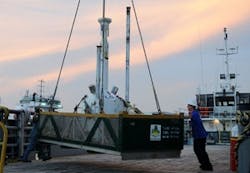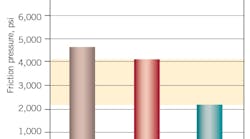Oil and gas executives report they are beginning to see some relief in drilling and completion costs, partially because service companies have become more willing to renegotiate contracts.
Producers are examining variable-pricing contract structures. Such contracts typically are tied to oil futures prices or the Baker Hughes rig count.
Doug Sheridan, managing director and founder of EnergyPoint Research Inc., sees a movement away from fixed-price contracts toward prices that reflect commodity prices, especially on the international oil markets.
For example, a drilling contract could contain day rates based upon predetermined price points such as if crude falls below $50/bbl for 30 days, he said. His independent market research firm specializes in monitoring customer satisfaction in the oil and gas industry.
Bill Hale of Ernst & Young LLP also said he sees a more variable pricing structure for drilling contracts within the US, based upon dropping revenues and a sluggish Baker Hughes Inc. rig count.
US drilling activity increased for the first time in 11 weeks, up by 23 rotary rigs to 899 drilling for the week ended June 19—the same number as 3 weeks earlier but down from 1,906 during the same period a year ago, Baker Hughes reported in its weekly statistics.
Ensco International Inc. reports the Ensco 8500 started operations during June in the Gulf of Mexico. The first of seven new ultradeepwater semisubmersibles, Ensco 8500 has a 4-year contract with Anadarko Petroleum Corp. and Eni. Photo from Ensco International.
Barclays Capital Inc. analysts on June 22 forecast that worldwide exploration and production expenditures will reach $387 billion during 2009, which would be down 15% from last year. The forecast was based upon a survey of 402 companies.
“Growth in E&P is anticipated to return in 2010 by over half of the companies surveyed,” said Barclays Capital analyst James D. Crandell in New York.
Producers’ strategies vary
Occidental Petroleum Corp. Pres. Stephen Chazen said Occidental is renegotiating supplier contracts and laying down rigs. The company’s first-quarter financial results included an $8 million pretax charge for terminated rig contracts.
Oxy expects a 20%-25% cost reduction across all areas compared with 2008 costs, he said. He expects the full effect of the cost reductions to be realized during the rest of this year and going into 2010.
Devon Energy Corp. Pres. John Richels in May said that Devon’s costs have dropped 10-15% from the beginning of 2009, and the company expects costs to come down another 10-20% by yearend.
Apache Corp. stopped drilling in Oklahoma because rig rates were too high, compared with current natural gas prices. While it currently has no rigs running in Oklahoma, Apache said it had about 25 rigs drilling there last summer.
Speaking at the Reuters Global Energy Summit in Houston during early June, Apache Chief Executive Officer Steve Farris said he expects to see exploration costs continue to decline despite a recent rise in crude oil prices.
Rig rates in Oklahoma were about $12,000/day in early June. Farris said he expects that will fall to $7,500/day, which would be comparable with 2004 day rates. Rig rates in Oklahoma were $24,000/day last year.
Clayton Williams Energy Inc. plans to increase spending in response to lower drilling and completion costs and higher oil prices. The company plans two oil drilling projects in second-half 2009 in the Permian basin and Austin chalk.
The two projects will utilize up to five drilling rigs owned by Desta Drilling, the operating name for Larclay LP, a Clayton Williams Energy wholly owned subsidiary.
“Since we can control costs more effectively by using our own drilling rigs and by entering into firm pricing arrangements with our service providers, we feel confident in our ability to carry out our current plan under existing market conditions,” said Clayton W. Williams Jr., president.
For the year ending December 2009, Clayton Williams Energy plans to spend $107.7 million on exploration and development activities compared with its earlier plans to spend $78.5 million.
Jack up market deteriorates
Analysts with Raymond James & Associates Inc. have said the jack up market continues to deteriorate, and they expect offshore drilling contractors will need to continue stacking capacity.
Pritchard Capital Partners analysts said the Gulf of Mexico market already was weak before the arrival of hurricane season, which typically means minimal demand exists for small well jobs.
Ensco International Inc. reported in June that it had a total of nine jack ups idle. Ensco coldstacked its first two rigs, both in the Gulf of Mexico. The Ensco 90, a 24-year-old rig, was stacked along with the Ensco 60, a 28-year-old rig.
The Ensco 81, a 350-ft independent-leg cantilever (IC) jack up, had its indexed rate with Mexico’s Petroleos Mexicanos cut $65,000 to $100,000/day, Pritchard analyst Stephen Berman said on June 16.
The Ensco 99, 250-ft IC jack up, had its current contract expiration extended 1 month at $75,000/day and then it will begin a 1-well job for Newfield Exploration Co. at $48,000/day, which Pritchard Capital called the lowest rate recorded for a 250-ft IC in the gulf.
The contract for Ensco 75, a 400-ft IC, expired and the rig is expected to be idle in July, Ensco said in a recent fleet status report. However, Ensco’s deepwater expansion program is progressing and will buffer some weakness in its jack up business.
Dan Rabun, Ensco chairman, president, and chief executive officer, said the company has committed more than $3 billion to construct seven rigs to expand its ultradeepwater fleet.
Ensco 8500, the first of seven new ultradeepwater semisubmersibles, started working during June in the gulf under a 4-year contract, signed in 2005, with Anadarko Petroleum Corp. and Eni.
The second semi in the series, Ensco 8501, was delivered in June from a shipyard and is mobilizing to the gulf with drilling operations scheduled to start in October.
Land Rigs stabilize
Helmerich & Payne Inc. disclosed in a US Securities and Exchange Commission filing during June that its US land rig count has stabilized since its April earnings report. As of June 15, the contract said 107 of 209 rigs, or 51%, were on contract and generating revenues, with 88 on long-term contracts.
Since Apr. 30, two more newbuild FlexRigs received early terminations, bringing H&Ps total contract terminations to 37, the company said. For international rigs, 14 of 32 were idle in June, implying 56% utilization.


